The Hermitage (Nashville, Tennessee)
The Hermitage is a historical plantation and museum located in Davidson County, Tennessee, United States, 10 miles (16 km) east of downtown Nashville. The 1,000 acre, self-sustaining plantation relied completely on the labor of enslaved African American men, women and children[3] and was owned by Andrew Jackson, the seventh President of the United States, from 1804 until his death at the Hermitage in 1845. It also serves as his final resting place. [4] Jackson only lived at the property occasionally until he retired from public life in 1837. It is a National Historic Landmark.
The Hermitage | |
 The Hermitage | |
| Location | 4580 Rachel's Ln Hermitage, TN 37076 |
|---|---|
| Coordinates | 36°12′53.9″N 86°36′46.7″W |
| Area | 1,120 acres (450 ha)[1] |
| Built | 1835 (current form) |
| Architect | Joseph Reiff and William C. Hume |
| Architectural style | Greek Revival |
| NRHP reference No. | 66000722 |
| Significant dates | |
| Added to NRHP | October 15, 1966 |
| Designated NHL | December 19, 1960[2] |
Mansion and grounds
Architecture
The Hermitage is built in a secluded meadow that was chosen as a house site by Rachel Jackson, wife of Andrew Jackson. From 1804 to 1821, Jackson and his wife lived in a log cabin. Together, the complex formed the First Hermitage, with the structures known as the West, East, and Southeast cabins.[5]
Jackson commissioned construction of a more refined house, and the original mansion was a two-story, Federal-style building built with bricks manufactured onsite by skilled people. Construction took place between 1819 and 1821. The house had four rooms on the ground floor and four rooms on the second level, each with a fireplace and chimney. The large central hallways opened in warm weather from front to back to form a breezeway. A simple portico was added later. In 1831, while Jackson was residing in the White House, he had the mansion remodeled under the direction of architect David Morrison. The new structure included flanking one-story wings, a one-story entrance portico with 10 columns, and a small rear portico that gave the house a Classical appearance.
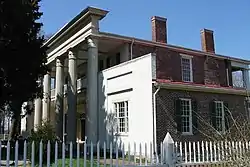
In 1834, a chimney fire seriously damaged the house, with the exception of the dining room wing. This led to Jackson having the current 13-room, Greek Revival structure built on the same foundation as the former house. It was completed two years later. The architects for the house were Joseph Reiff and William C. Hume, who also built Tulip Grove across the road.
The mansion has a rectangular layout, about 104 feet (32 m) from east to west and 54 feet (16 m) from north to south. The south front is the location of the main entrance and includes a central block with a five-bay, two-story structure with a portico supported by six modified Corinthian style, wooden columns with a simple entablature resting on the capitals. Within the portico is a second-story balcony with simple square balusters. One-story wings with single fenestrations flank the mansion and extend beyond it to the front of the portico, enclosing it on three sides. While the southern façade gives the appearance of a flat roof, the three other elevations show that the tin-covered roof is pitched. The front façade was painted a light tan, and a sand coating was added to the columns and trim to simulate the appearance of stone. A near replica of the front portico is found on the north end of the house, although it features Doric-style columns and is capped with a pediment.[6][7][8]
Interior
The layout of the main block of the house consists of four large rooms separated by a center hall. The entry hall with plank flooring painted dark is decorated with block-printed wallpaper by Joseph Dufour et Cie of Paris, depicting scenes from Telemachus' visit to the island of Calypso.[9][lower-alpha 1] At the far end of the hall is the elliptical cantilevered staircase with mahogany handrail that leads to the second level. To the left of the hall are the front and back parlors, featuring crystal chandeliers and Italian marble mantels. Leading from the front parlor is the dining room in the east wing.
Decorated with a high-gloss paint to reflect as much light as possible, the fireplace features a rustic mantelpiece called the "Eighth of January". It was carved by a veteran of the Battle of New Orleans, who worked on the mantelpiece on each anniversary of the battle until he finished on January 8, 1839. Jackson installed the piece on the next anniversary a year later on January 8, 1840.[7] Adjacent to the dining room is a pantry and storage room that leads to an open passageway to the kitchen. This was built separate from the house to reduce the risk of fire to the main house as well as eliminate the noise, heat, and odors of cooking. To the right of the entrance hall, accessible via a side hall, are two bedrooms that were occupied by President Jackson and his son, Andrew Jackson, Jr. A spacious library and office used by Jackson and others to manage the plantation are located in the west wing.
On the second level are four bedrooms used by family members and guests, including Sam Houston, and Presidents James K. Polk and Martin Van Buren.[8]
Grounds
The site today covers 1,120 acres (450 ha), which includes the original 1,050-acre (420 ha) tract of Jackson's plantation. It is overseen and managed by The Andrew Jackson Foundation, formerly called the Ladies' Hermitage Association. The mansion is approached by a cedar-lined, 10-foot (3.0 m) wide, guitar-shaped carriage drive designed by Ralph E. W. Earl. The design made it easier to maneuver carriages in the narrow space. To the east of the house was a 1-acre (0.40 ha) formal garden designed by Philadelphia-based gardener William Frost in 1819. Laid out in the English four-square kitchen garden style, it consists of four quadrants and a circular center bed contained by unusually long, beveled bricks and pebbled pathways. Originally, the garden was primarily used to produce food for the mansion and secondarily as an ornamental pleasure garden. It is surrounded by a white picket fence. On the north perimeter stands a brick privy that served as a status symbol as well as a garden feature.[10]
After Rachel Jackson died in 1828, Jackson had her buried in the garden she loved. When he had the house remodeled in 1831, Jackson also had a Classicizing "temple & monument" constructed for Rachel's grave. Craftsmen completed the domed limestone tomb with a copper roof in 1832.[11]
.jpg.webp)
Behind the mansion, the property includes a smokehouse that date to the early 19th century. The large brick smokehouse at the rear of the kitchen was built in 1831 and cured 20,000 pounds (9,100 kg) of pork a year. Nearby is a cabin known as Uncle Alfred's Cabin. Alfred Jackson was born a slave of Andrew Jackson at the Hermitage around 1812 and worked there in various jobs.[12] After the Civil War, he stayed as a tenant farmer and later worked as caretaker and guide following the purchase of the estate in 1889 by the Ladies' Hermitage Association. Jackson died in 1901 and was buried near the tomb of the President and Mrs. Jackson.[9]
Two other cabins were built from materials of the First Hermitage. After Jackson built the main house, the two-story log structure he had lived in for 15 years was disassembled, and the materials were used to build two one-story buildings used as quarters.[9]
From 1988 to 2005, teams conducted extensive archaeological work at the plantation. Their work revealed the location of an ice house behind the smokehouse and hundreds of thousands of artifacts. A brick triplex of cabins that was likely used by domestics and artisans was discovered near the mansion yard. Remains of three dug-in-ground pits suggest there were at least two log houses and four brick duplexes.[5] The cotton gin and press were located in one of the cotton fields just beyond the First Hermitage.
History
The plantation that Jackson named Hermitage was located 2 miles (3.2 km) from the Cumberland and Stones Rivers after Native Americans had been pushed out of the region. The land was originally settled in 1780 by Robert Hays, who was the grand uncle [13] of Texas Ranger John Coffee Hays and Confederate General Harry Thompson Hays. Hays sold the 420-acre (170 ha) farm to Jackson in 1804.[lower-alpha 2]
Cotton plantation
Jackson and his wife moved into the existing two-story log blockhouse, built to resist Indian attacks. He added a lean-to on the back of the cabin and to the rear erected a group of log outbuildings, including cabins, store rooms, and a smokehouse. This complex is known historically as the First Hermitage.[5] This scale of operation ranked him as a major planter in middle Tennessee.
In 1818–19, prior to his appointment as provisional Governor of the Florida Territory, Jackson built a brick house to replace the log structure he had lived in after purchasing the plantation. He also added six brick structures, containing a total of 13 20-by-20-foot (6 by 6 m) dwelling units for the people he enslaved. These included a three-unit building known as the Triplex, built behind the mansion. A two-unit duplex known as the South Cabin was built at the First Hermitage. Four brick duplexes were built at the Field Quarter and were known as Cabins 1, 2, 3, and 4. At least one Field Cabin was still standing as late as the 1920s.[5]
Elected President in 1828, Jackson enlarged the Hermitage during his first term. After an 1834 fire destroyed much of the interior of the house, he rebuilt and refurnished it. At the end of his second term in 1837, Jackson retired to the Hermitage, where he died in 1845. Andrew Jackson was buried in the garden next to his wife.
Throughout his life, Jackson expanded the plantation to an operation of 1,000 acres (400 ha), with 200 acres (81 ha) used for cotton, the commodity crop, and the remainder for food production and breeding and training racehorses.
Jackson's adopted son, Andrew Jackson, Jr., inherited the estate. Due to debt and bad investments, Jackson Jr. began selling off portions of the estate. In 1856, he sold the remaining 500 acres (200 ha), the mansion, and the outbuildings to the State of Tennessee, with a provision that the Jackson family could remain in residence as caretakers of the estate. The state intended to turn over the property to the federal government for use as a southern branch of the United States Military Academy, but the outbreak of the American Civil War in 1861 disrupted this plan.[14]
Civil War and afterwards
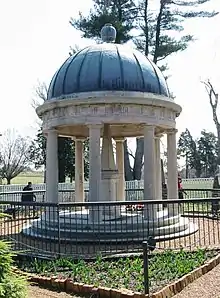
On May 5, 1863, units of the Union Army from Indiana approached the Hermitage. Pvt. Joseph C. Taylor wrote an account in his diary:
At 2 this morning Co.'s according to previous agreement, saddled up and started for a big scout. About daylight we arrived at Stone River. Colonel McCook was with us. We used great caution while crossing the river. We formed a line of battle and crossed a Company at a time, forming a line on the opposite side. We all crossed in safety, and proceeded to the Hermitage of General A. Jackson, where we halted for a while. Thin by orders of the Colonel went to see the hermitage also the tomb of General A. Jackson. I will describe the place as well as I can. There is a nise gravel road from the Main road to the house. On each side of this mall there is a nise row of large cedar trees, which almost darken the passage as the branches meet overhead. When in 20 steps of the front door, this road forks and directly in front is a space in the shape of a heart. Around this the road runs, which enables the carriage to come up to the door. This heart is enclosed by a similar row of cedars. The inside of this heart, and also on each side of the carriage way is thickly set with pines, cedars and other shrubbery of long standing, which almost excludes the sun shining on the ground. There is nise gravel walks leading to every place that a person want to go. From appearances those walks are but little used, as the grass is growing in the walks to some extent. We then went in the garden which is situated on the East of the house. Which is between the house and the Lebanon Pike, and is full of shrubbery and flowers of all kinds. Also walks running in all directions which beautifies the place and also give it a cold look to me, as I never saw a garden arrainged in this fashion. In the South East corner of this garden stands the monument of General Andrew Jackson. General Jackson lies on the South side of the tomb. His head in the direction of West, his feet to the East. His wife lies on the North and 2 infant children lie on the South of the tomb. It is all together a dark and secluded spot and looks to me as though it was verry old fassion.
— Pvt. Joseph C. Taylor, Co. I, 2nd Indiana Cavalry[15]
Museum
Andrew Jackson's grandson, Andrew Jackson III, and his family were the last to occupy the Hermitage. The family moved out in 1893, and it ceased being a family residence. The Hermitage was opened to the public by the Ladies' Hermitage Association, who had been deeded the property by the state of Tennessee for use as a museum of both Jackson's life and the antebellum South in general. The Association restored the mansion to its appearance in 1837. Over time, the organization bought back all the land that had been sold, taking ownership of the last parcel that restored the plantation boundaries in 2003.[8]
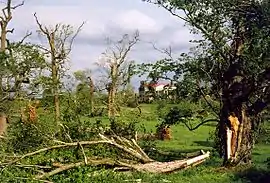
The Hermitage escaped disaster during the 1998 Nashville tornado outbreak. An F-3 tornado crossed the property at about 4 p.m. on April 16, 1998, missing the house and grave site but toppling 1,000 trees on the estate, many that were reportedly planted by Jackson himself nearly 200 years earlier.[16] The trees once hid the house from passers-by on U.S. Route 70, but their loss left the mansion in plain sight.
Using wood from the fallen trees, Gibson Guitar Corporation produced 200 limited-edition "Old Hickory" guitars. The first guitar produced was presented to the Smithsonian, although as of 2018, it was not on display.[17]
The mansion is the most accurately preserved early presidential home in the country. Each year, the home receives more than a quarter million visitors, making it the fourth-most-visited presidential residence in the country (after the White House, Mount Vernon, and Monticello). The property was declared a National Historic Landmark in 1960.[2][18][19]
Confederate Soldiers Home Cemetery
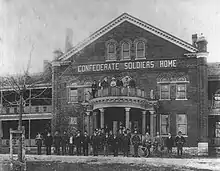
Part of the Hermitage estate that passed in to public hands became the site of the state-funded Confederate Soldiers Home, a residential facility that housed poor and disabled Confederate veterans beginning in 1892.[20] More than 480 veterans who died there were buried in an onsite cemetery, each marked with a white, military-style gravestone and arrayed in circles around a monumental stone.[21]
Legacy
The city in Davidson County where the Hermitage is located is known as Hermitage, Tennessee. A hotel named the Hermitage Hotel, located in downtown Nashville, opened in 1910 and is still operating. Many celebrities and U.S. presidents have spent time there.[22]
In popular culture
- The plantation is prominently featured in one of the opening scenes of F. Scott Fitzgerald's unfinished novel, The Last Tycoon (1941), when the narrator, Celia, visits it with two other characters.
- The Hermitage was one of the filming locations and settings for the 1955 Disney film Davy Crockett, King of the Wild Frontier.
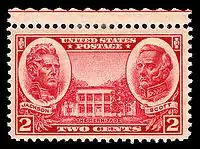
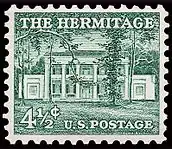
See also
Notes
- Examples of this wallpaper are more often found in New England; the Hermitage paper must have been imported through New Orleans and shipped up the Mississippi River.
- Additional purchases of adjoining tracts increased the plantation to 640 acres (260 ha).
References
- Williams, William (October 28, 2014). "'Presidential sites are extremely meaningful places'". Nashville Post. Retrieved March 3, 2015.
- "National Historic Landmarks Program - The Hermitage". National Park Service. Archived from the original on March 10, 2009. Retrieved December 30, 2008.
- "Slavery | Andrew Jackson's Hermitage Plantation". The Hermitage. Retrieved January 26, 2021.
- "Andrew Jackson's Enslaved Laborers". Hermitage. Retrieved November 29, 2020.
- Galle, Jillian E.; Cooper, Leslie; Sawyer, Jesse; Bollwerk, Elizabeth; Bates, Lynsey A. (2012). "Building a chronology for domestic slave sites at The Hermitage" (PDF). The Digital Archaeological Archive of Comparative Slavery. Retrieved February 20, 2015.
- Capen, Oliver Bronson (October 1905). Country Homes of Famous Americans. Doubleday, Page & Co. p. 101. OCLC 1200545.
- Smith, J. Frazer (1993) [1941]. Plantation Houses and Mansions of the Old South. Dover Publications. p. 33. ISBN 978-0-486-27848-3.
- "The Hermitage Mansion Story". TheHermitage.com. Retrieved January 28, 2015.
- The Historic Hermitage Properties: A Handbook. Hermitage, TN: Ladies' Hermitage Association. 1972. OCLC 379550.
- Yamin, Rebecca; Metheny, Karen Bescherer, eds. (1996). Landscape Archaeology: Reading and Interpreting the American Historical Landscape. The University of Tennessee Press. p. 74. ISBN 978-0-87049-920-3.
- "The Hermitage: Home of President Andrew Jackson". Nashville Life. Retrieved February 13, 2015.
- https://thehermitage.com/history-from-home-alfred-jackson. Missing or empty
|title=(help) - John Coffee Hays pedigree at RootsWeb; J. H. Garner Genealogy Database, last updated March 2015. Retrieved February 16, 2016.
- "The Hermitage". National Park Service. Retrieved February 25, 2013.
- "Book #6 of Pvt. Joseph C. Taylor". Iamonia.bravehost.com. Archived from the original on July 8, 2011. Retrieved December 30, 2008.
- "Davidson/Wilson County Tornado". Nashville, Tennessee: National Weather Service. April 10, 2013. Retrieved April 11, 2013.
- "Gibson Old Hickory Electric Guitar". Smithsonian Institution. Retrieved March 3, 2015.
- Sarles, Frank B.; Morton, III, W. B.; Rettig, Polly M.; McKithan, Cecil (July 24, 1978). "National Register of Historic Places Inventory - Nomination Form - The Hermitage". National Park Service. Retrieved December 30, 2008.
- Rettig, Polly M. (September 1975). "National Register of Historic Places Property Photograph Form - The Hermitage". National Park Service. Retrieved December 30, 2008.
- Brown II, Myers E. (2011). Tennessee's Confederates. Arcadia Publishing. p. 121. ISBN 978-0-7385-8719-6.
- Upton, Dell (2015). What Can and Can't be Said: Race, Uplift, and Monument Building in the Contemporary South. Yale University Press. p. 210. ISBN 978-0-300-21175-7.
- "The Hotel: Hotel History". TheHermitageHotel.com. 2003. Archived from the original on December 19, 2008. Retrieved December 30, 2008.
External links
| Wikimedia Commons has media related to The Hermitage (Nashville, Tennessee). |
- The Hermitage website
- "Tocqueville in Nashville", broadcast from the Hermitage, from C-SPAN's Alexis de Tocqueville tour.
- "Life Portrait of Andrew Jackson", broadcast from the Hermitage, from C-SPAN's American Presidents: Life Portraits, April 26, 1999
- Col. Robert Hays (1758-1819) at Find a Grave